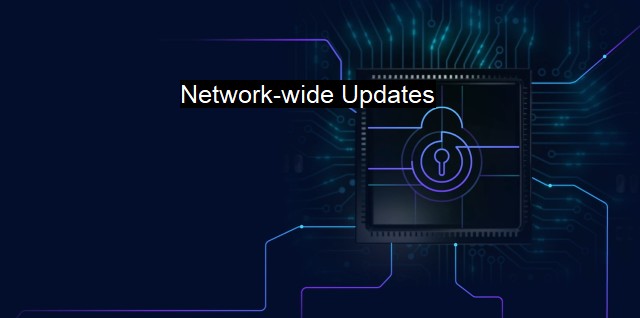What are Network-wide Updates?
The Crucial Role of Network-Wide Updates in Ensuring Cybersecurity and Antivirus: Protecting Vital Systems from Malware, Viruses and Hacking Attempts
Network-wide updates represent a vital process in cybersecurity measures, applicable to a broad range of structured connections including businesses, educational institutions, as well as governmental agencies. network-wide updates refer to the act of implementing upgrades across an entire network. It involves applying updates or patches to software and systems in different parts of an interconnected network to improve their performance, fix bugs and security vulnerabilities, and add new functionalities.Cybersecurity is a fundamental concern in the contemporary digital era as threats evolve and emerge at remarkable speeds. Often, these updates deal with cybersecurity threats where program developers respond to vulnerabilities identified in their systems. Accordingly network-wide updates often contain invaluable solutions to software insecurities that could compromise the integrity, availability, and confidentiality of a network's data.
It is important to assess the core importance of network-wide updates as part of cybersecurity. Firstly, the updates provide patches to known vulnerabilities, data breaches, or loopholes in the system's defense layers. Cyber attackers constantly explore these vulnerabilities, attempting to infiltrate systems and gain unauthorized access.
Secondly, network-wide updates also update the antivirus software across the network. An antivirus program is integral to safeguarding a network from a variety of threats, like malware, ransomware, phishing attacks, among others. Over time, methods used by these threats evolve, hence necessitating constant updates on the antivirus software.
Network-wide updates cover all devices connected to a network, which usually include computers, mobile devices, as well as cloud resources. It also touches aspects of firewalls and Internet of Things (IoT) devices. As per their nature, device updates occur collectively rather than in isolation; it generates a streamlined security protocol and counteracts potential loopholes that may have arisen from solo updates.
Implementing network-wide updates is typically done via an update management system which automates the process and screens for available updates. This comes handy in eliminating human errors or overlooking an update for critical software or antivirus, which could render a complete ecosystem susceptible to a cyberattack.
One might contest the complexity of network-wide updates if an organization uses different systems or brands, but developers tend to offer patches or updates that are widely compatible with other systems. Delays in implementing these updates leave an organization susceptible to ‘zero-day’ attacks, which exploit software vulnerabilities before a suitable patch or fix is devised.
The frequency and necessity of network-wide updates usually depend on the size and complexity of the relevant network, the significance of specific vulnerabilities identified, and an anticipated potency of the entire security model. with increasing reliance on networked systems and the advancement of cyber threats, the preparedness to deploy these updates promptly is crucial as an arm of effective cybersecurity strategies.
Network-wide updates or patches in cybersecurity often turn out to be invaluable procedures aiming to secure the infrastructure of a network, data and information of an organization. Such updates act as both preventive and protective measures against emerging cyber threats. Hence network-wide updates function as the network’s immune system, serving an anticipatory role in safeguarding against potential malfunction, glitches, or cyber-attacks. Thus, they play a crucial role in shaping a business or entity's cybersecurity strategy and remain continuously fundamental to the survival of any institution operating online.

Network-wide Updates FAQs
What are network-wide updates and why are they important for cybersecurity and antivirus?
Network-wide updates refer to updates that are applied to all devices within a network, such as computers, servers, and mobile devices. These updates are crucial for cybersecurity and antivirus because they help to patch vulnerabilities and security flaws to protect against potential threats.How often should network-wide updates be carried out for optimal cybersecurity and antivirus protection?
Network-wide updates should be carried out frequently, ideally every week or two, to ensure that all devices within the network are up-to-date with the latest security patches and antivirus definitions. This helps to prevent cyber attacks and keep sensitive data secure.What are some risks associated with delaying network-wide updates for cybersecurity and antivirus?
Delaying network-wide updates can leave devices within the network vulnerable to cyber attacks and malware infections. Hackers can exploit known vulnerabilities and security flaws, which can result in data breaches, identity theft, and other forms of cybercrime. It is important to implement updates as soon as possible to minimize the risk of these attacks.What measures can be taken to ensure that network-wide updates are carried out efficiently and without causing disruption to daily operations?
To ensure efficient and smooth network-wide updates, it is important to schedule updates during periods of low activity or outside of business hours. Additionally, it is important to inform employees and staff about the updates and any changes that may affect their work. Regular testing and monitoring of the network can also help to identify and address any issues that arise during or after updates.| | A | | | B | | | C | | | D | | | E | | | F | | | G | | | H | | | I | | | J | | | K | | | L | | | M | |
| | N | | | O | | | P | | | Q | | | R | | | S | | | T | | | U | | | V | | | W | | | X | | | Y | | | Z | |
| | 1 | | | 2 | | | 3 | | | 4 | | | 7 | | | 8 | | |||||||